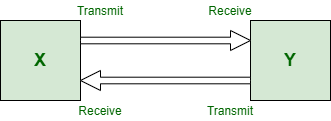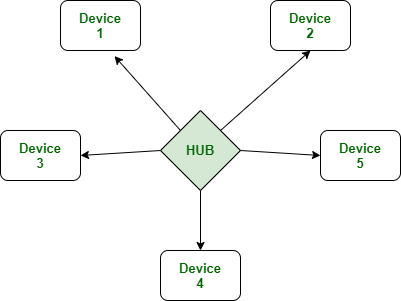Difference between Point to Point Link and Star Topology Network
Last Updated :
16 May, 2023
1. Point to point link : This is the kind of topology that relies upon two functions i.e. Transmit and Receive. It is a type of communication network between two communication nodes where there is one transmitter and on the other end, there is the receiver. It is a kind of communication medium which have two endpoints or end nodes. They provide high bandwidth
Strengths:
- Efficiency: P2P networks are highly efficient as they allow for direct communication between two devices without any intermediate devices or network components.
- Security: P2P networks are relatively more secure than other topologies as they do not rely on intermediate devices that can be compromised or attacked.
- Simple Configuration: P2P networks are easy to configure and require minimal management or administration.
Weaknesses:
- Limited Scalability: P2P networks are not scalable as adding new devices requires establishing a separate link between each new device and the existing network, which can be time-consuming and expensive.
- Maintenance: P2P networks can be difficult to maintain as each device has to be managed separately.
- Lack of Redundancy: P2P networks do not provide redundancy, which can be a problem if a link fails or a device goes offline. with a dedicated communication connection between two systems.

2. Star topology : It is that type of topology which contains a central node to which all of the other or different nodes are connected through a single path. In this topology, each and every host is connected to a central hub.
Strengths:
- Scalability: Star networks are highly scalable as new devices can be added easily by connecting them to the central hub or switch.
- Easy Management: Star networks are easy to manage as all devices are connected to a central hub or switch, making it easy to troubleshoot and maintain.
- Redundancy: Star networks provide redundancy as multiple paths exist between devices, reducing the risk of network failure.
Weaknesses:
- Cost: Star networks can be expensive as they require a central hub or switch, which can be costly.
- Single Point of Failure: Star networks have a single point of failure, which is the central hub or switch. If the hub or switch fails, the entire network becomes non-functional.
- Network Performance: The performance of a star network depends on the capacity of the central hub or switch. If the hub or switch is not able to handle the traffic, the network performance can be impacted.

Similarities between P2P Link and Star Topology Networks:
- Data Transmission: Both P2P Link and Star Topology Networks are used for transmitting data between network-enabled devices. They provide a communication medium that enables devices to communicate with each other.
Wired and Wireless Connections: Both P2P Link and Star Topology Networks can use either wired or wireless connections. Wired connections include Ethernet cables, while wireless connections include Wi-Fi or Bluetooth.
- Network Devices: Both P2P Link and Star Topology Networks can include various network devices, such as computers, servers, routers, switches, or any other network-enabled devices.
- Security: Both P2P Link and Star Topology Networks can implement security measures to protect the network and the data transmitted over it. For example, both network types can use encryption to secure data.
- Fault Tolerance: Both P2P Link and Star Topology Networks can implement fault tolerance mechanisms to ensure network reliability. For example, redundant links can be used in P2P Link Networks to provide backup communication paths, while in Star Topology Networks, a backup hub or switch can be used to ensure network uptime.
Difference between Point to Point Link and Star Topology Network :
| Point to point link |
Star topology |
| It grows in several ways. |
It helps in providing easy access for service. |
| This is the type of link which basically relies upon two functions only transmit and receive. |
Only one device is there for per connection. |
| Each station or nodes receives exactly from one transmitter. |
It is very reliable. |
| Each transmitter transmits to exactly one receiver. |
It has a centralized control for the problem diagnosis. |
| Both the transmit and receive operation can occur over separate wires. |
It has simple access protocols. |
| It is the type of high bandwidth network. |
It has a very long cable length network. |
| Very fast network topology as compared to the other network types. |
All of the dependency is there on the central node. |
| It is very simple and easy in connectivity. |
It is a high performing as there are no collisions on data. |
| Helps in providing low latency. |
It is very easy to detect faults and remove parts. |
| It is very easy to maintain and handle. |
It is more expensive than other network topologies. |
| Their nodes can be replaced within a seconds very easily. |
It is very easy to install and wire. |
Conclusion :
both Point-to-Point Link and Star Topology Networks have their strengths and weaknesses, and the choice between them depends on the specific networking requirements. A P2P Link Network is ideal for fast, secure data transfer between two devices, while
Share your thoughts in the comments
Please Login to comment...